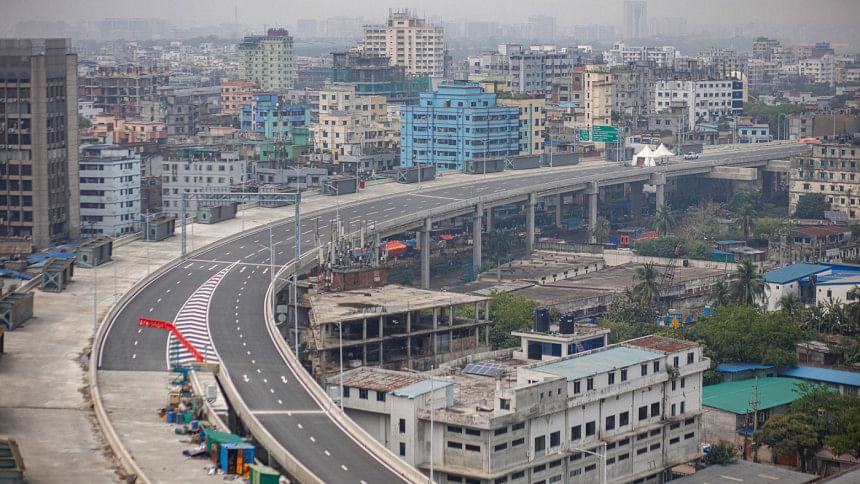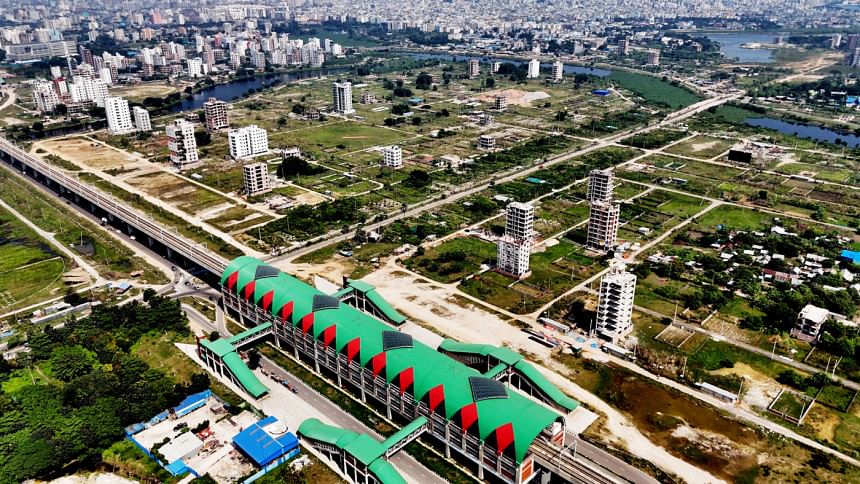Tomorrow’s Dhaka: Mega projects reshaping the capital’s housing landscape

Mega-projects like MRT-6 and the Dhaka Elevated Expressway are redefining urban living in Dhaka, a city of 20 million people. These infrastructure projects have increasingly contributed to alleviating traffic issues and bringing order to the communication system, resulting in smoother commutes and better access to essential locations for city dwellers. These improvements have also had a positive impact on the real estate sector, boosting growth and increasing the desirability of properties near these modern transportation nodes.
"The government's decision to implement the metro rail and elevated expressway was pivotal. In developed countries, commuting between downtown areas and residential neighborhoods is effortless and swift—a concept previously unimaginable for us. The real estate sector is reaping the benefits of these significant communication projects, with promising prospects for further growth," says Md. Wahiduzzaman, President of REHAB.
Land prices near metro stations have surged, even in previously vacant areas, leading to increased demand for flats in these zones. This trend is expected to continue with more metro projects underway. Improved communication infrastructure has eased transportation challenges in areas like Uttara and Mirpur, with a substantial number of metro stations enhancing connectivity.
While development is predominantly concentrated on the northern side of the first MRT line, with noticeable growth in areas like Uttara or Mirpur, this trend is not as evident in the southern regions of Motijheel or Kawranbazar, which were already developed before the establishment of the MRT line and face scarcity of available land.
"Previously overlooked areas such as Uttara and Purbachal, which had vacant spaces, are now witnessing increased development activity as people seek to establish their residential foothold in these regions. Land developers have responded to this growing demand, anticipating the establishment of the MRT line, which was not previously a consideration. While there was traditionally high demand for flats in established areas like Dhanmondi, Lalmatia, and Kalabagan, there is now a shift in preference towards areas with upcoming MRT extensions, reflecting a strategic outlook for future housing investments," shares Mehedi Hasan, Chief Design Coordinator of Credence Housing Ltd."
Interestingly, he also notes that while the price of flats has remained stagnant in Mirpur, it has surged in Uttara. In Uttara, the cost of constructing quality-standard flats now stands at a minimum of BDT 8,000 per square foot, with companies aiming to sell them at around BDT 10,000 per square foot. This increase has prompted an influx of the upper-middle class to Uttara, while the lower-middle class is left with limited options. The escalating prices of land and construction materials shrink the scope for affordable housing.

He further points out that the government has introduced several measures to incentivize development near metro stations. These measures include exemptions for individuals who own flats within 500 meters of a metro station.
Ongoing infrastructure projects also boost demand for developers in adjacent areas, while the Elevated Expressway linking Banani and Gulshan eases travel for residents and businesses.
"The recent improvements in communication, particularly the Metro connecting Uttara to inner Dhaka, have sparked a substantial rise in demand for flats in Uttara and Mirpur. Similar positive developments have been observed in Banani, attributed to the benefits of the elevated expressway. With travel time reduced to as little as 7 to 8 minutes between Banani and Farmgate, compared to the previous 1 to 2 hours, the appeal of these areas has significantly increased," mentions A K M Rafiul Islam, Head of Sales at Sheltech (Pvt.) Ltd.
"In Uttara, where we currently have over 15 projects, we are committed to providing nature-friendly housing solutions that meet all compliance standards, as per customer demands. Additionally, we strive to offer flats at the most affordable prices possible. Presently, approximately 40 percent of our clients are seeking flats in Uttara and Mirpur. Although the government allocates lands in Uttara, Mirpur is primarily dominated by private ownership, albeit with the presence of the National Housing Authority. However, due to the higher land prices in Uttara compared to Mirpur, the cost of apartments is also elevated in Uttara," Rafiul adds.
"Our premier projects in Banani and Baridhara have experienced a surge in valuation, both internally and in terms of overall impact. The accessibility factor has significantly contributed to this appreciation. Members of our premier group, as well as our target demographic, now benefit from improved time management, effortlessly navigating between their business and residential destinations. Notably, convenient access to the airport from areas like Uttara and Banani has further elevated the appeal of these locations," states Bishazit Das, Assistant Manager of Business Development at Navana Real Estate.

The evident positive impact of the mega projects is increasingly tangible, as customers' investments indicate a shift towards what is now acknowledged as a smart investment.
"As a result of these two transformative infrastructural projects, our overall valuation has seen a remarkable increase of 20-25 percent. In Mirpur, where we have a condominium housing project named City Within, residents are relishing the benefits of enhanced connectivity, thanks to the MRT line. With the ability to reach major areas of Dhaka within 20 minutes, the project has become immensely appealing. Consequently, the valuation of our project in Mirpur has surged by an impressive 40 percent, offering added value to our discerning customers," adds Bishazit Das.
While acknowledging the positive impacts of mega projects on Dhaka's housing sector, it's imperative to acknowledge potential unintended consequences that could impede their overall success. Despite the metro rail's aim to improve public transportation for all, there's a risk that its benefits may disproportionately favor only a select segment of society. Poor management of these mega projects could exacerbate social divisions, and their positive effects might prove to be short-lived.
Dr. Adil Mohammed Khan, a Professor at the Department of Urban and Regional Planning, Jahangirnagar University, underscores that globally, the establishment of metro stations drives up land values, stimulates real estate growth, and boosts commercial activity. However, uncontrolled development can result in gentrification, displacing residents due to soaring prices—a phenomenon to which Dhaka is not immune. Dr. Khan highlights inadequate government control mechanisms and a lack of oversight from Rajuk regarding the development of metro lines.
Prioritizing sustainability in both the residential and transportation sectors is crucial for ensuring long-term benefits for all residents of Dhaka. This entails aligning development with the objective of fostering inclusive urban environments. By addressing pressing issues and fostering collaboration among stakeholders, Dhaka can maximize the positive impacts of mega projects, alleviate drawbacks, and ensure a sustainable future for all its citizens.
Dr. Adil Mohammed Khan further warns, "If Rajuk fails to implement mechanisms to ensure that middle and lower-middle-income individuals can remain in the vicinity of metro stations, they risk being completely marginalized. Without effective control mechanisms, the benefits of metro rails may remain inaccessible to lower-income groups. Real estate companies also bear responsibility in ensuring that lower-middle-class individuals can afford to reside in areas adjacent to metro stations."
Collaborative efforts between the government, Rajuk, and real estate developers are indispensable for mitigating the adverse effects of gentrification and creating inclusive urban spaces where people from all socioeconomic backgrounds can flourish.

 For all latest news, follow The Daily Star's Google News channel.
For all latest news, follow The Daily Star's Google News channel. 



Comments